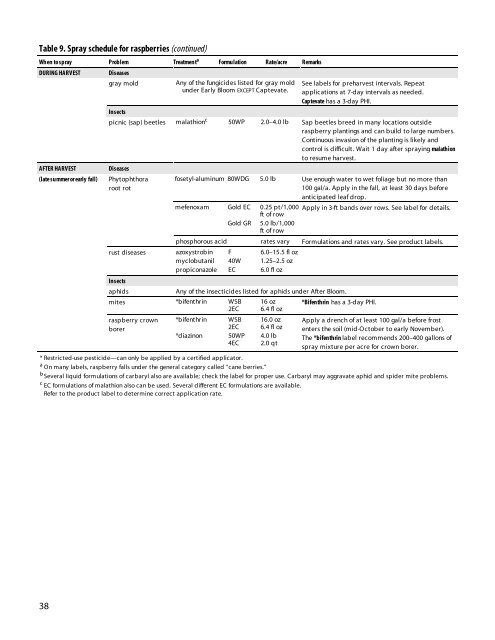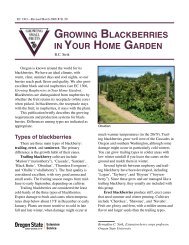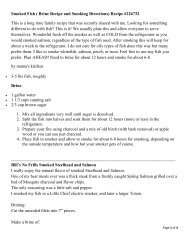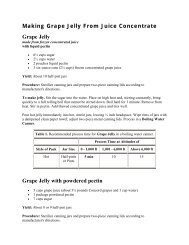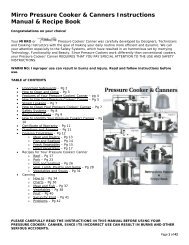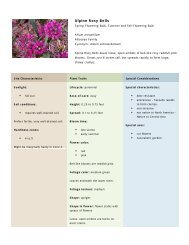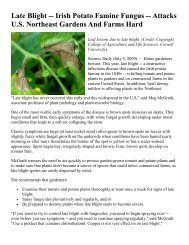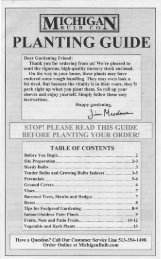Strawberry and Raspberry Pest Management in Wisconsin
Strawberry and Raspberry Pest Management in Wisconsin
Strawberry and Raspberry Pest Management in Wisconsin
Create successful ePaper yourself
Turn your PDF publications into a flip-book with our unique Google optimized e-Paper software.
Table 9. Spray schedule for raspberries (cont<strong>in</strong>ued)<br />
When to spray Problem Treatment a Formulation Rate/acre Remarks<br />
DURING HARVEST Diseases<br />
38<br />
gray mold Any of the fungicides listed for gray mold<br />
under Early Bloom EXCEPT Captevate.<br />
Insects<br />
AFTER HARVEST Diseases<br />
(late summer or early fall) Phytophthora<br />
root rot<br />
See labels for preharvest <strong>in</strong>tervals. Repeat<br />
applications at 7-day <strong>in</strong>tervals as needed.<br />
Captevate has a 3-day PHI.<br />
picnic (sap) beetles malathion c 50WP 2.0–4.0 lb Sap beetles breed <strong>in</strong> many locations outside<br />
raspberry plant<strong>in</strong>gs <strong>and</strong> can build to large numbers.<br />
Cont<strong>in</strong>uous <strong>in</strong>vasion of the plant<strong>in</strong>g is likely <strong>and</strong><br />
control is difficult. Wait 1 day after spray<strong>in</strong>g malathion<br />
to resume harvest.<br />
fosetyl-alum<strong>in</strong>um 80WDG 5.0 lb Use enough water to wet foliage but no more than<br />
100 gal/a. Apply <strong>in</strong> the fall, at least 30 days before<br />
anticipated leaf drop.<br />
mefenoxam Gold EC 0.25 pt/1,000<br />
ft of row<br />
Gold GR 5.0 lb/1,000<br />
ft of row<br />
Apply <strong>in</strong> 3-ft b<strong>and</strong>s over rows. See label for details.<br />
phosphorous acid rates vary Formulations <strong>and</strong> rates vary. See product labels.<br />
rust diseases azoxystrob<strong>in</strong> F 6.0–15.5 fl oz<br />
myclobutanil 40W 1.25–2.5 oz<br />
propiconazole EC 6.0 fl oz<br />
Insects<br />
aphids Any of the <strong>in</strong>secticides listed for aphids under After Bloom.<br />
mites *bifenthr<strong>in</strong> WSB 16 oz<br />
2EC 6.4 fl oz<br />
raspberry crown<br />
borer<br />
*bifenthr<strong>in</strong> WSB 16.0 oz<br />
2EC 6.4 fl oz<br />
*diaz<strong>in</strong>on 50WP 4.0 lb<br />
4EC 2.0 qt<br />
*Bifenthr<strong>in</strong> has a 3-day PHI.<br />
Apply a drench of at least 100 gal/a before frost<br />
enters the soil (mid-October to early November).<br />
The *bifenthr<strong>in</strong> label recommends 200–400 gallons of<br />
spray mixture per acre for crown borer.<br />
* Restricted-use pesticide—can only be applied by a certified applicator.<br />
a On many labels, raspberry falls under the general category called “cane berries.”<br />
b Several liquid formulations of carbaryl also are available; check the label for proper use. Carbaryl may aggravate aphid <strong>and</strong> spider mite problems.<br />
c EC formulations of malathion also can be used. Several different EC formulations are available.<br />
Refer to the product label to determ<strong>in</strong>e correct application rate.


